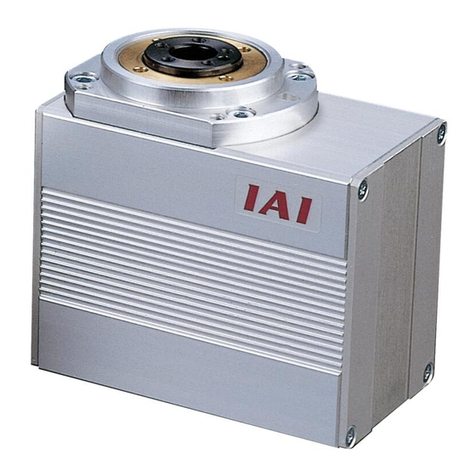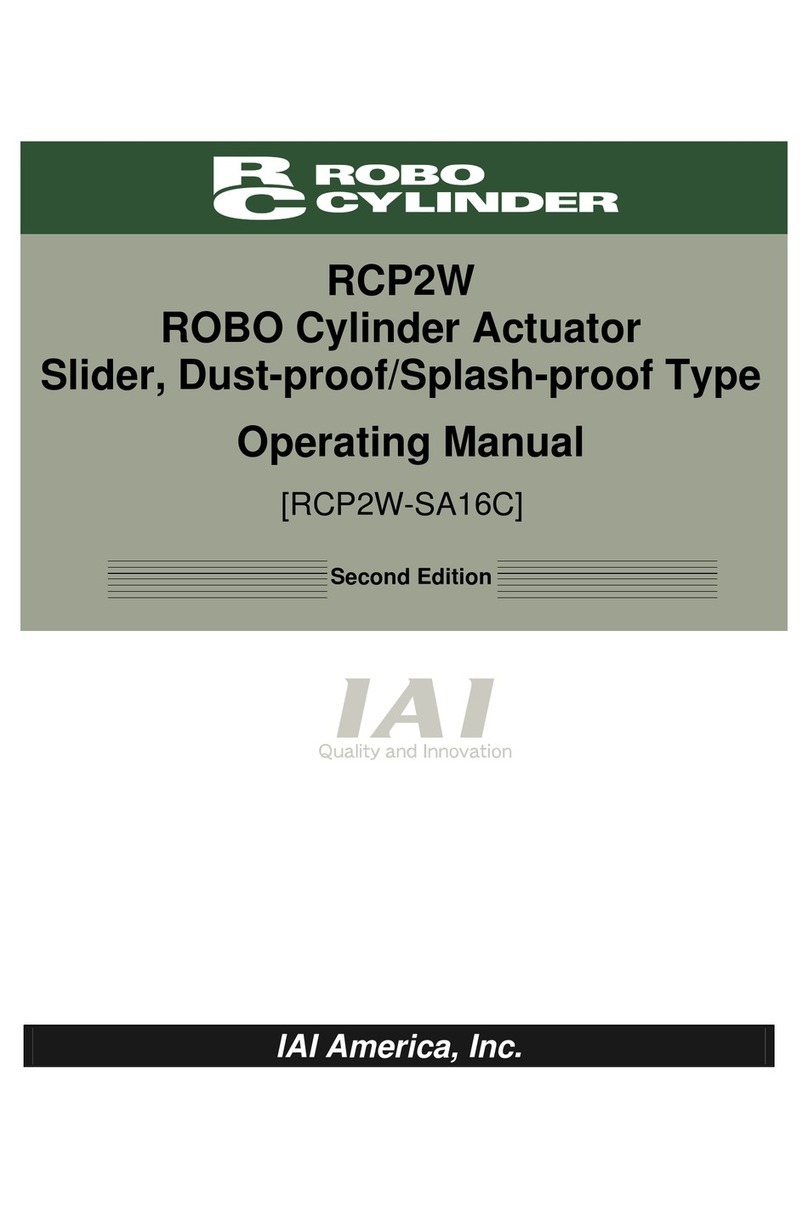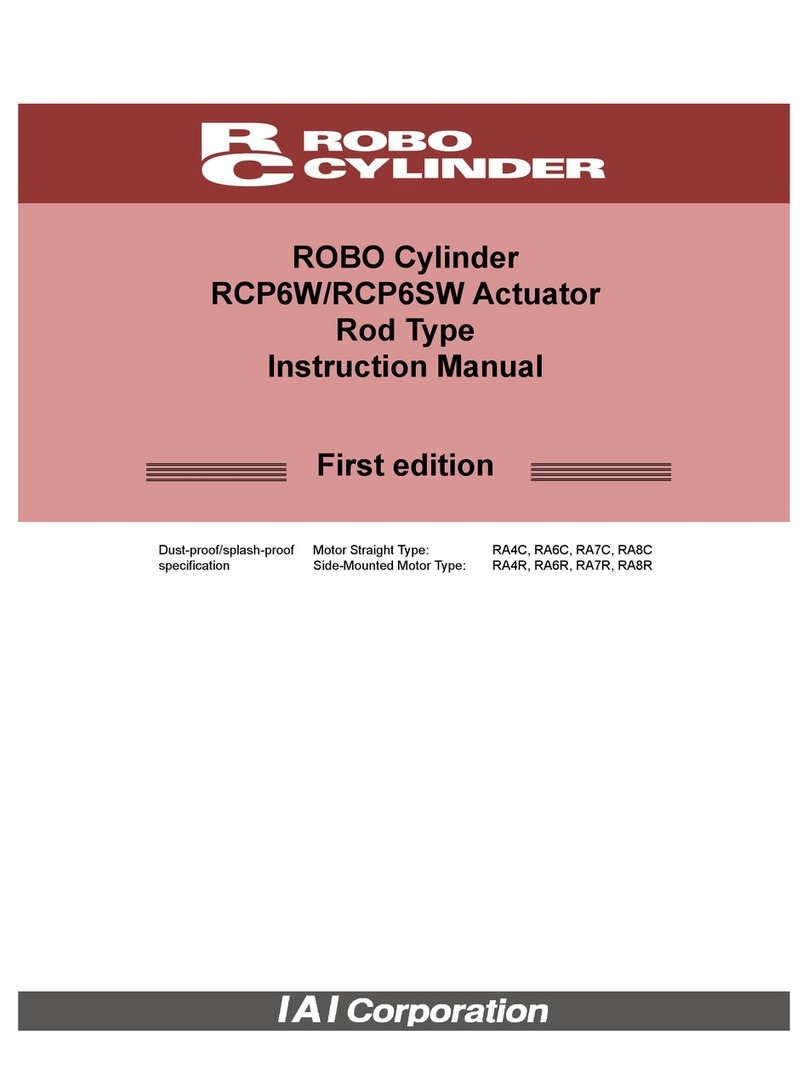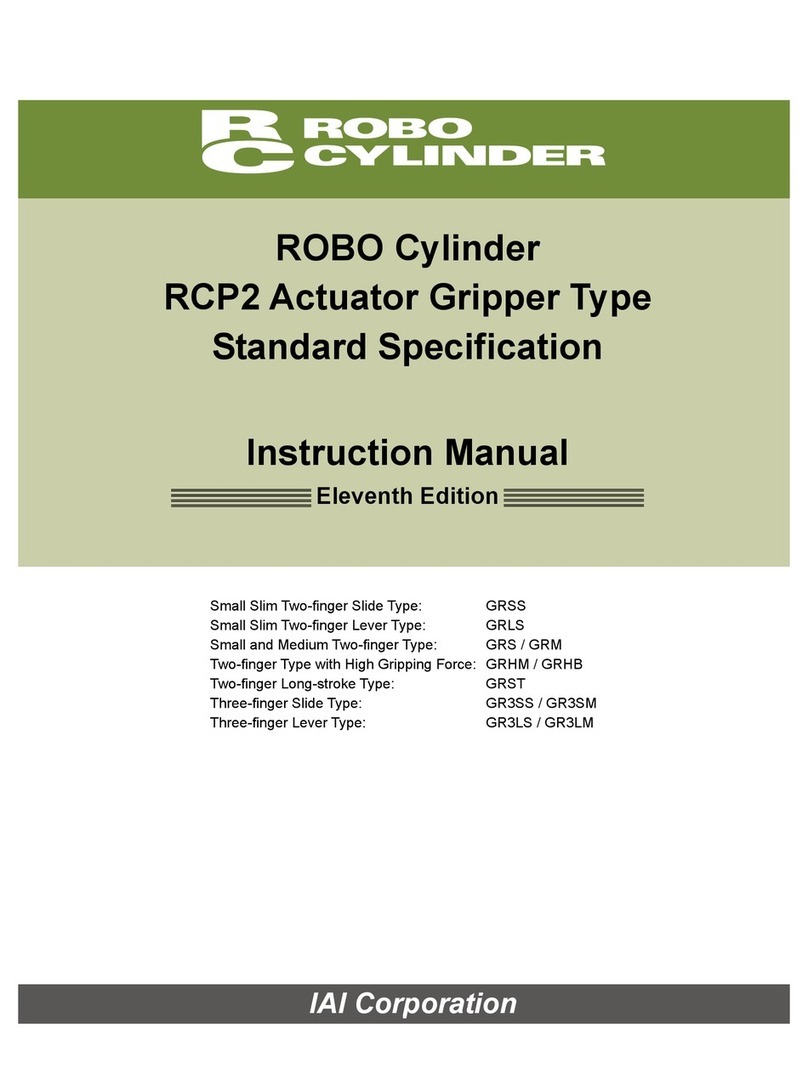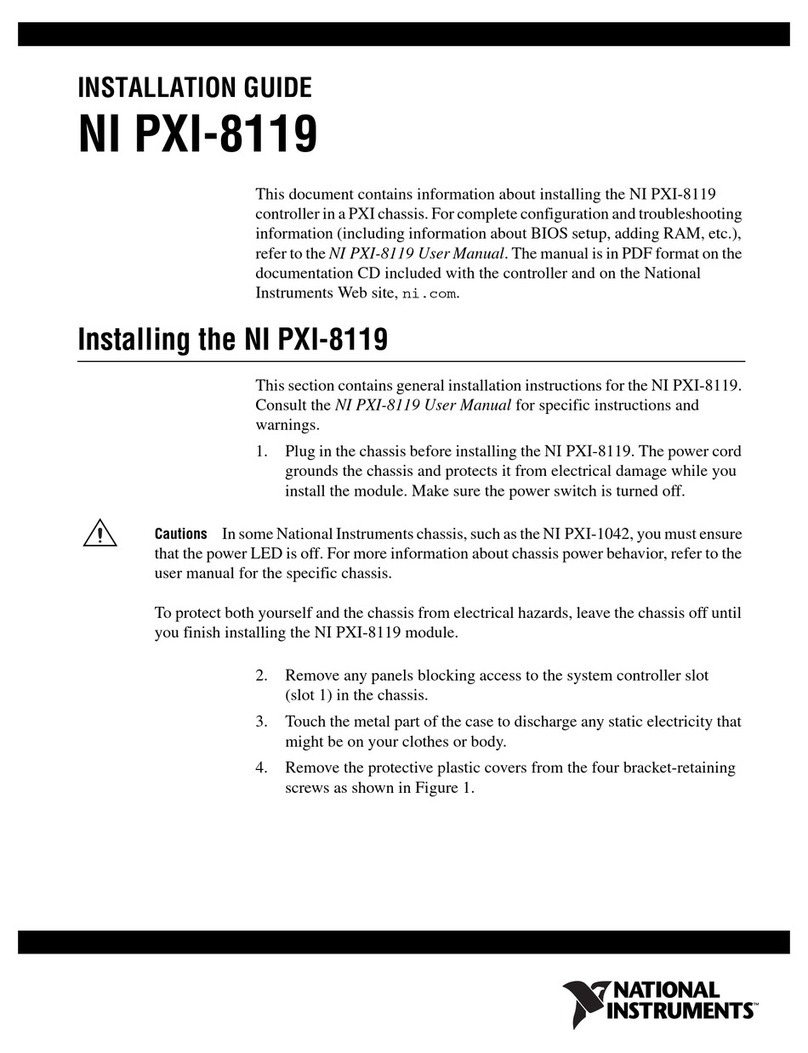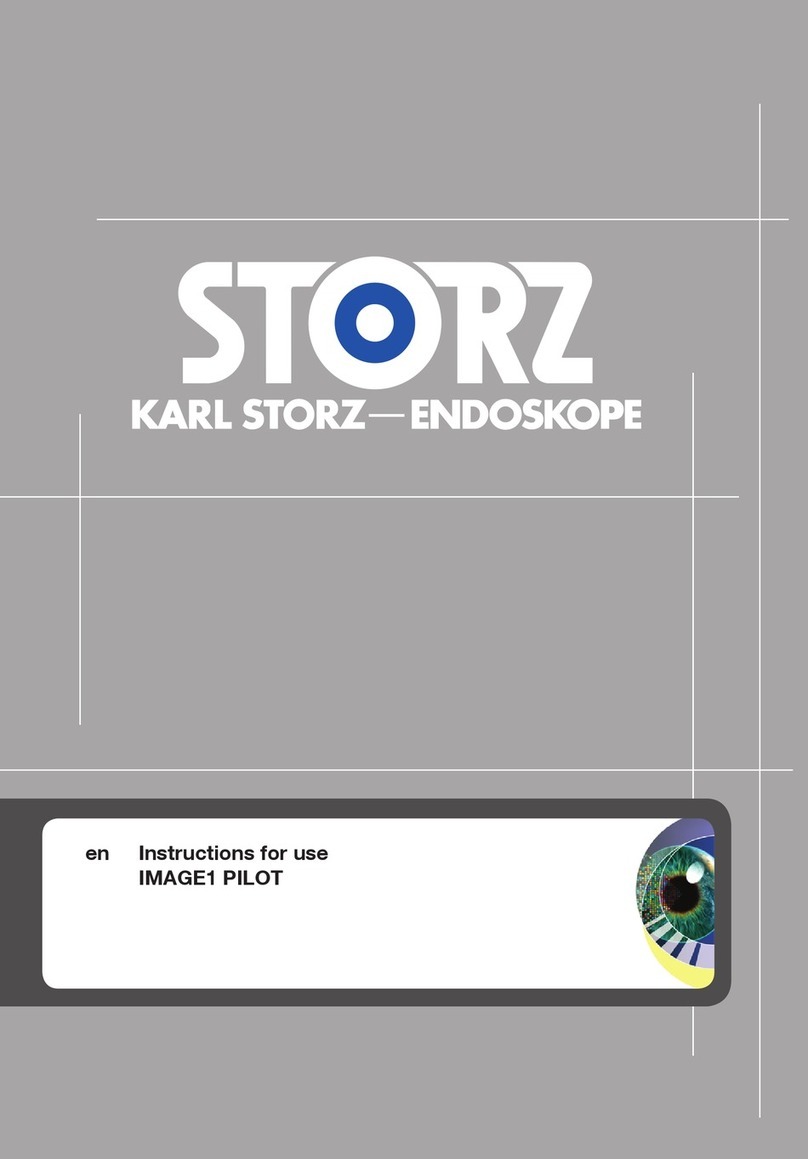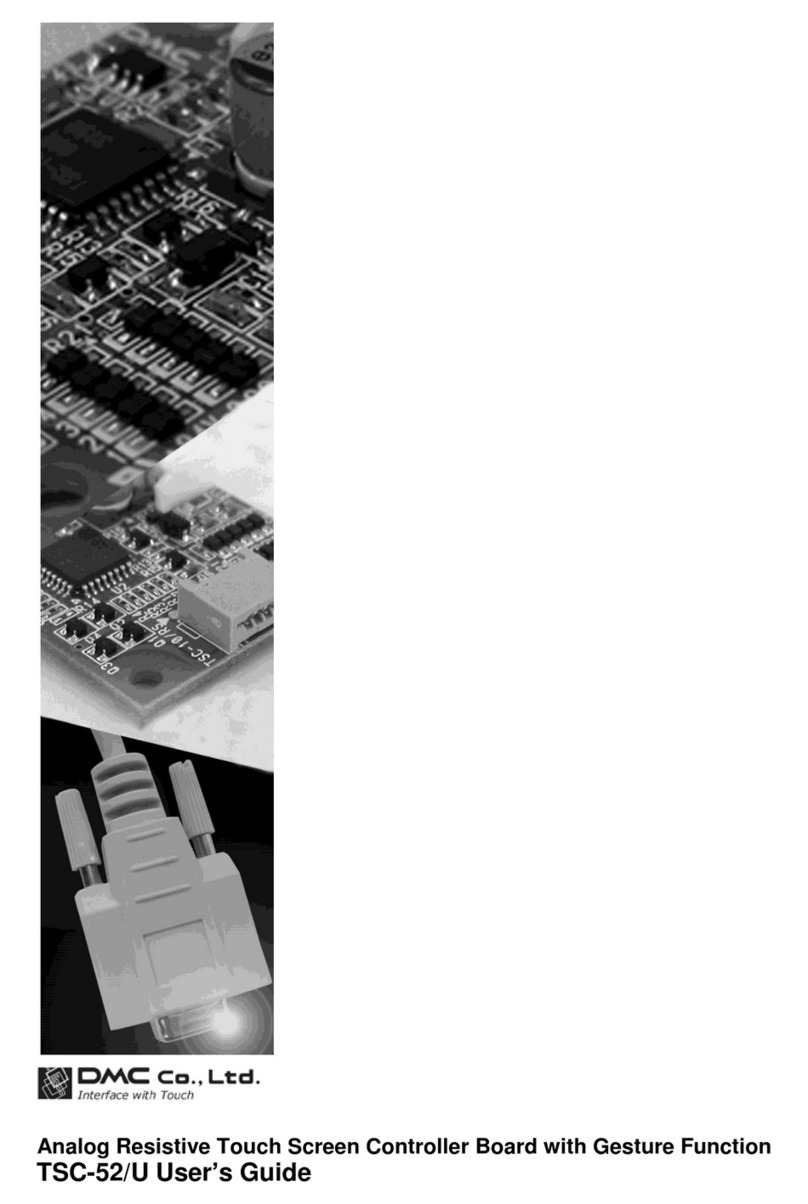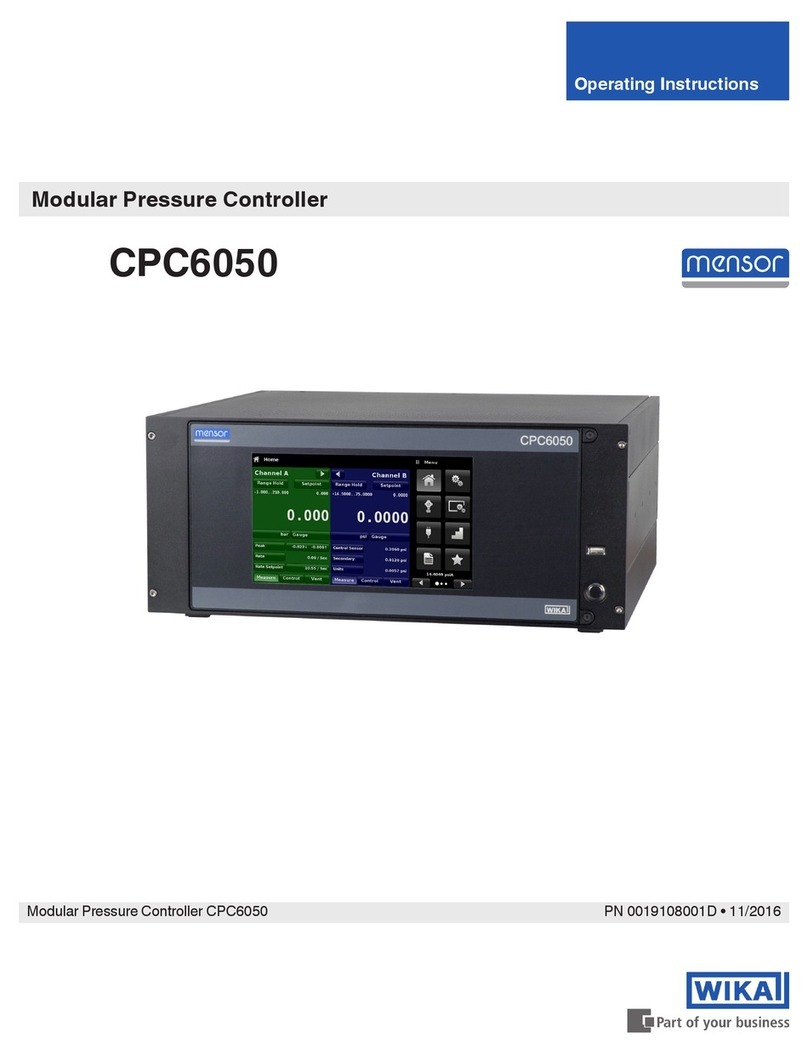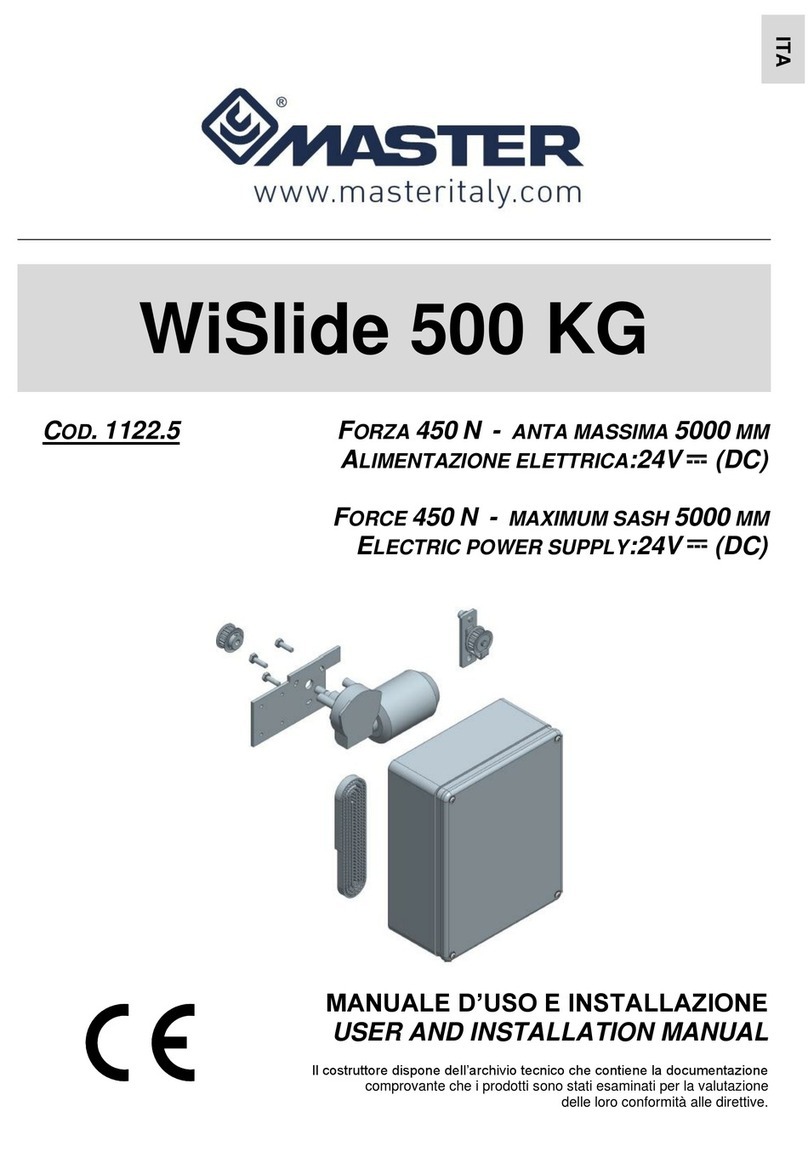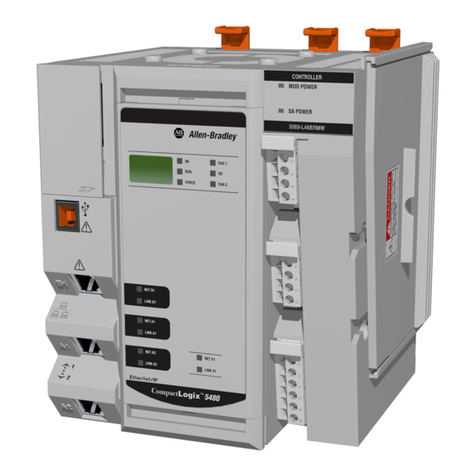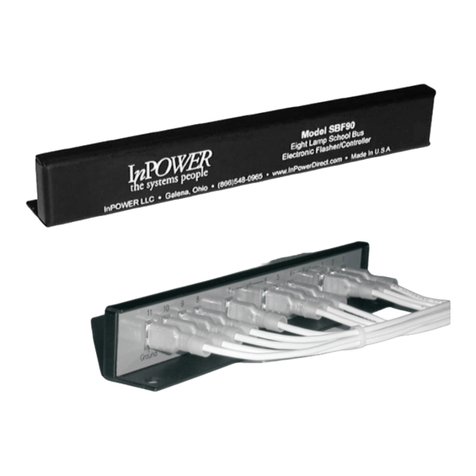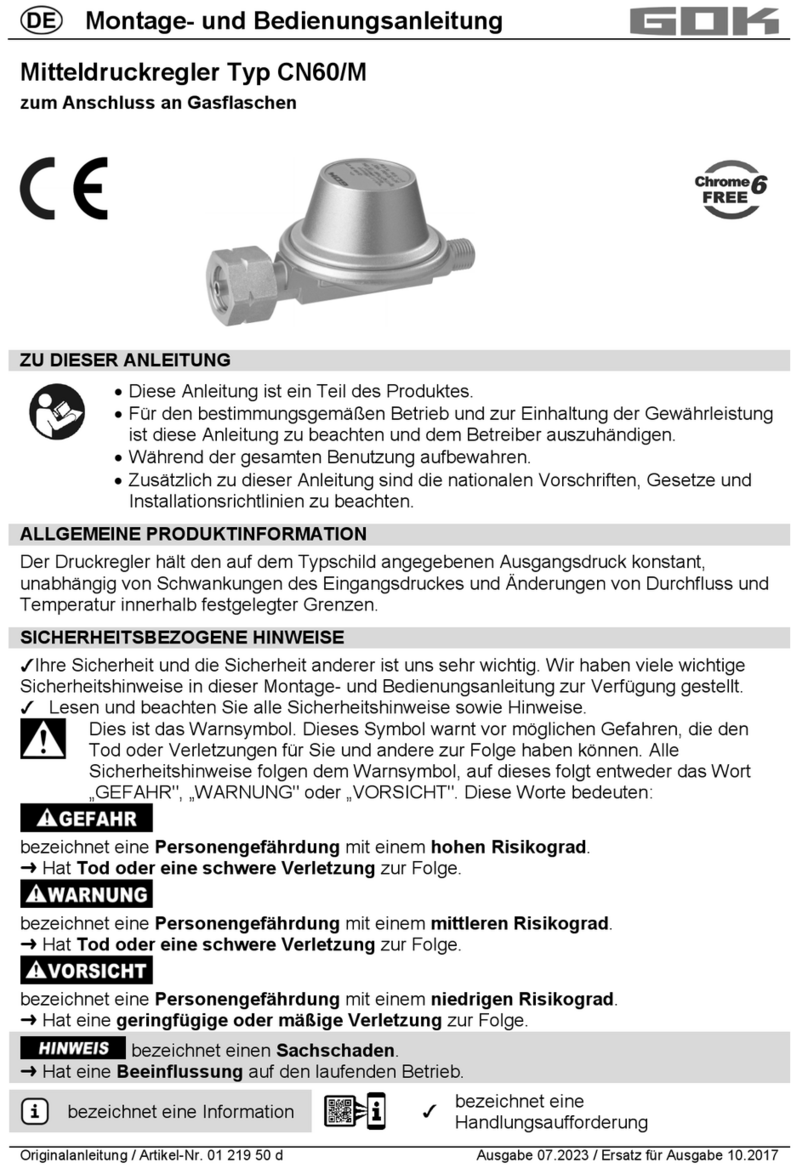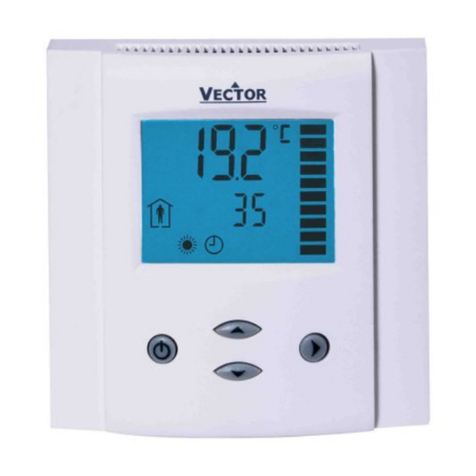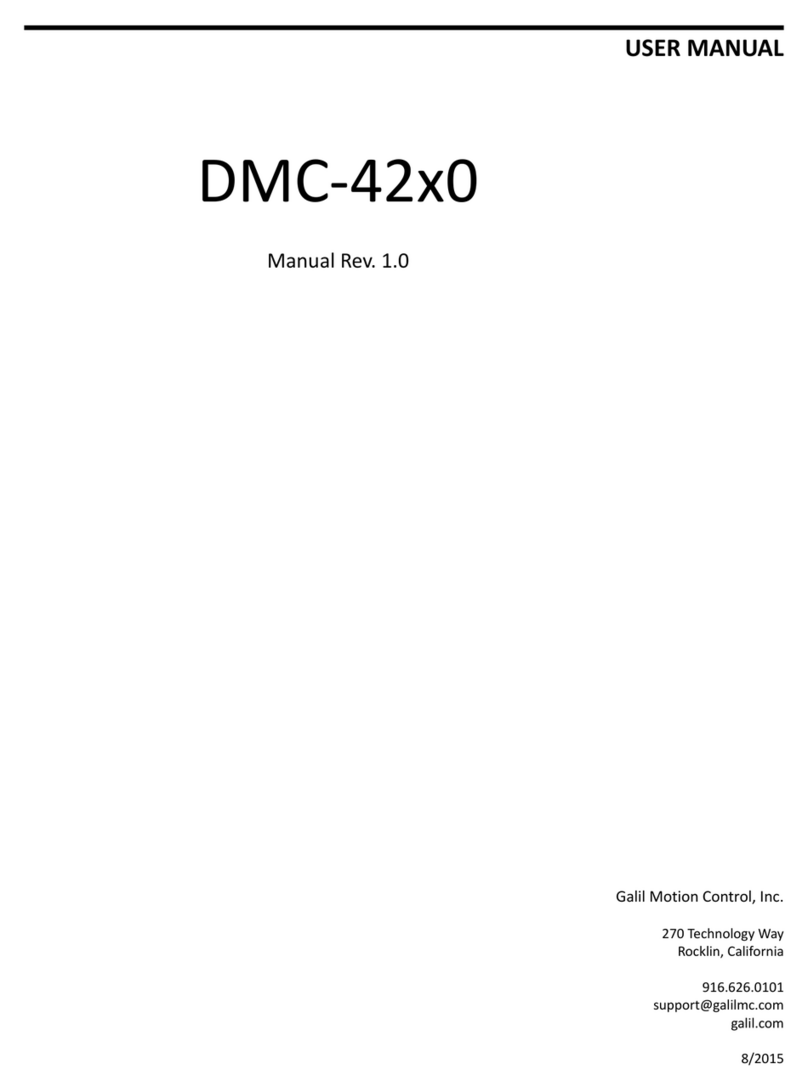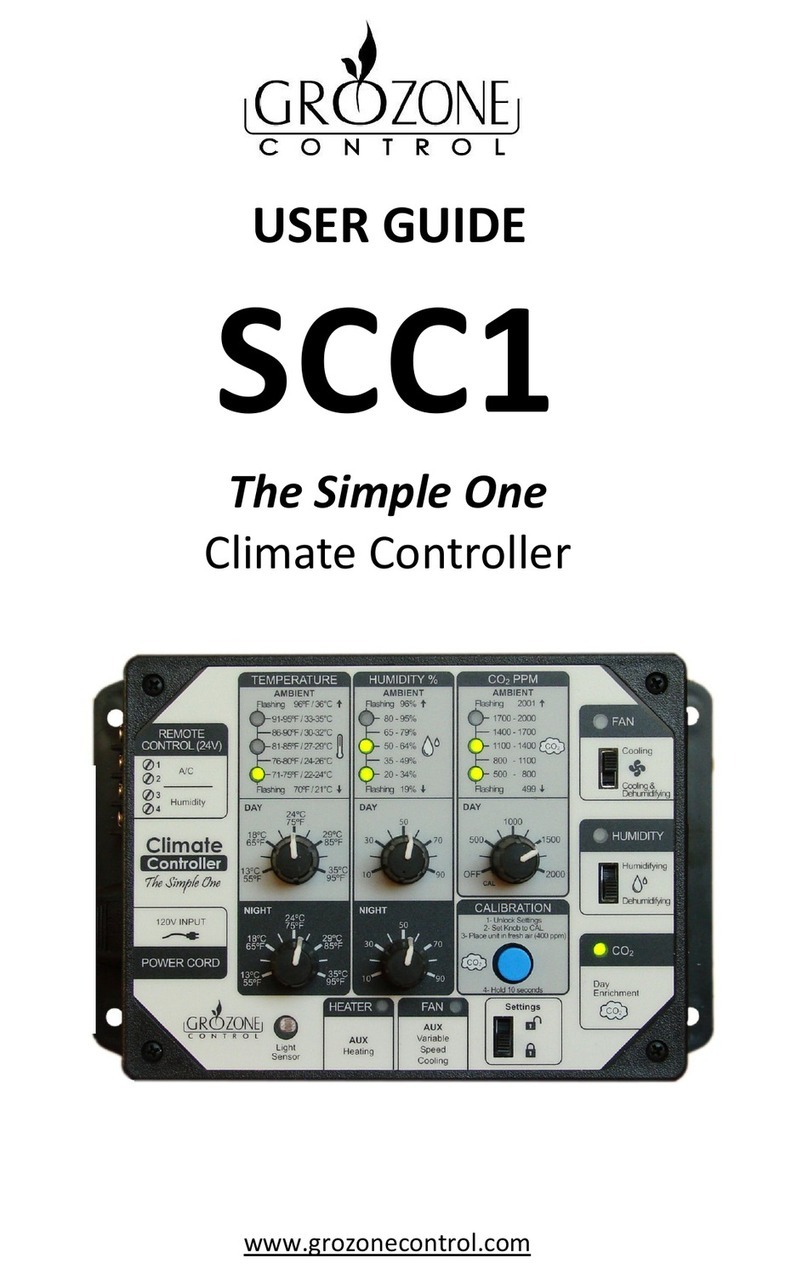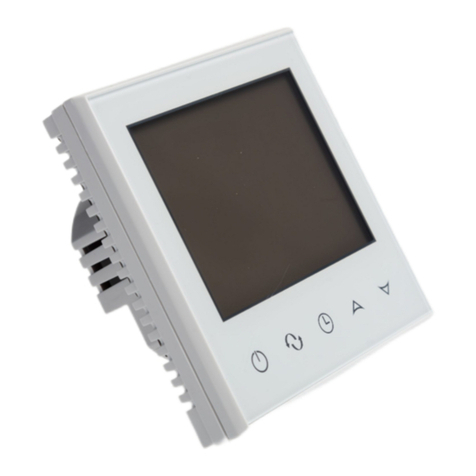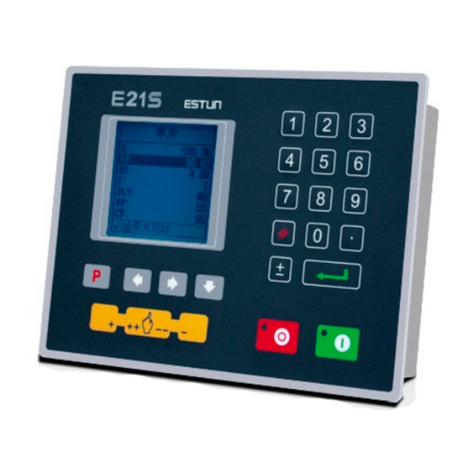ROBO Cylinder RCP5-BA4 User manual

IAI America, Inc.
ROBO Cylinder
RCP5 Actuator Belt Type
Instruction Manual
First Edition
BA4/BA4U
BA6/BA6U
BA7/BA7U


Please Read Before Use
Thank you for purchasing our product.
This instruction manual explains the handling methods, structure and maintenance of this product,
among others, providing the information you need to know to use the product safely.
Before using the product, be sure to read this manual and fully understand the contents explained herein
to ensure safe use of the product.
The DVD that comes with the product contains instruction manuals for IAI products.
When using the product, refer to the necessary portions of the applicable instruction manual by printing
them out or displaying them on a PC.
After reading the instruction manual, keep it in a convenient place so that whoever is handling this
product can reference it quickly when necessary.
[Important]
This instruction manual is original.
This product is not to be used for any other purpose from what is noted in this instruction
manual. IAI shall not be liable whatsoever for any loss or damage arising from the result of using
the product for any other purpose from what is noted in the manual.
The information contained in this instruction manual is subject to change without notice for the
purpose of production improvement.
If you have any question or finding regarding the information contained in this instruction manual,
contact our customer center or our sales office near you.
Using or copying all or a part of this instruction manual without permission is prohibited.
The company names, names of products and trademarks of each company shown in the
sentences are registered trademarks.


Table of Contents
Safety Guide ........................................................................................................... 1
Caution in Handling ................................................................................................ 8
International Standards Compliances ..................................................................... 9
Names of the Parts ............................................................................................... 10
1. Specifications Check ........................................................................................ 11
1.1 Checking the Product ........................................................................................................ 11
1.1.1 Parts ..................................................................................................................... 11
1.1.2 Related Instruction Manuals for the Each Controller Supported by This
Product ................................................................................................................. 11
1.1.3 How to Read the Model Nameplate ..................................................................... 11
1.1.4 How to Read the Model Number .......................................................................... 12
1.2 Specifications .................................................................................................................... 13
1.2.1 Speed ................................................................................................................... 13
1.2.2 Speed and Payload .............................................................................................. 14
1.2.3 Driving System • Position Detector ...................................................................... 18
1.2.4 Positioning Precision ............................................................................................ 18
1.2.5 Allowable Moment for Actuator ............................................................................ 19
1.3 Options .............................................................................................................................. 20
1.3.1 Brake Type (Model: B) ......................................................................................... 20
1.3.2 Reversed-home Specification (Model: NM) ......................................................... 20
1.3.3 Cable Eject Direction Changed (Model: CJT, CJR, CJL, CJB) ............................ 20
1.3.4 Ceiling Mount Type (Model: CIM), Left Horizontally Oriented Wall Mount Type
(Model: SIL) and Right Horizontally Oriented Wall Mount Type (Model: SIR). .... 20
1.4 Motor • Encoder Cables .................................................................................................... 21
1.4.1 Motor • Encoder Integrated Cables ...................................................................... 21
1.4.2 Motor • Encoder Integrated Cables Robot Type .................................................. 22
2. Installation ....................................................................................................... 23
2.1 Transportation ................................................................................................................... 23
2.2 Installation and Storage • Preservation Environment ........................................................ 25
2.3 How to Install ..................................................................................................................... 26
2.3.1 Installation Orientation ......................................................................................... 26
2.3.2 Installation ............................................................................................................ 27
3. Connecting with the Controller ........................................................................ 32
4. Maintenance and Inspection ........................................................................... 36
4.1 Inspection Items and Schedule ......................................................................................... 36
4.2 External Visual Inspection ................................................................................................. 37
4.3 Cleaning ............................................................................................................................ 37
4.4 Internal Inspections ........................................................................................................... 37
4.4.1 Check Condition and Dirt of Lubricant ................................................................. 38
4.4.2 Inspection of the Belt ............................................................................................ 39
4.5 Internal Cleaning ............................................................................................................... 40
4.6 Grease Supply ................................................................................................................... 40
4.6.1 What Grease to Use ............................................................................................. 40
4.6.2 How to Apply Grease ........................................................................................... 41
4.7 Procedures for Replacement and Adjustment of Stainless Steel Sheet ........................... 44
4.7.1 Preparation ........................................................................................................... 44
4.7.2 Procedure for Replacement and Tuning .............................................................. 45

4.8 Procedure for Belt Replacement and Tuning .................................................................... 48
4.8.1 Tension Adjustment ............................................................................................. 48
4.8.2 Replacement of the Belt....................................................................................... 51
4.9 Replacement Process ....................................................................................................... 60
5. External Dimensions....................................................................................... 71
5.1 RCP5-BA4/BA4U .............................................................................................................. 71
5.2 RCP5-BA6/BA6U .............................................................................................................. 72
5.3 RCP5-BA7/BA7U .............................................................................................................. 73
6. Life.................................................................................................................. 74
6.1 How to Calculate Operation Life ....................................................................................... 74
6.2 Operation Life.................................................................................................................... 75
7. Warranty ......................................................................................................... 76
7.1 Warranty Period................................................................................................................. 76
7.2 Scope of the Warranty....................................................................................................... 76
7.3 Honoring the Warranty ...................................................................................................... 76
7.4 Limited Liability.................................................................................................................. 76
7.5 Conditions of Conformance with Applicable Standards/Regulations, Etc.,
and Applications ................................................................................................................ 77
7.6 Other Items Excluded from Warranty ................................................................................ 77
Change History..................................................................................................... 78

1
Safety Guide
“Safety Guide” has been written to use the machine safely and so prevent personal injury or property
damage beforehand. Make sure to read it 1before the operation of this product.
Safety Precautions for Our Products
The common safety precautions for the use of any of our robots in each operation.
No. Operation
Description Description
1 Model
Selection
● This product has not been planned and designed for the application
where high level of safety is required, so the guarantee of the protection
of human life is impossible. Accordingly, do not use it in any of the
following applications.
1) Medical equipment used to maintain, control or otherwise affect human
life or physical health.
2) Mechanisms and machinery designed for the purpose of moving or
transporting people (For vehicle, railway facility or air navigation
facility)
3) Important safety parts of machinery (Safety device, etc.)
● Do not use the product outside the specifications. Failure to do so may
considerably shorten the life of the product.
● Do not use it in any of the following environments.
1) Location where there is any inflammable gas, inflammable object or
explosive
2) Place with potential exposure to radiation
3) Location with the ambient temperature or relative humidity exceeding
the specification range
4) Location where radiant heat is added from direct sunlight or other large
heat source
5) Location where condensation occurs due to abrupt temperature
changes
6) Location where there is any corrosive gas (sulfuric acid or hydrochloric
acid)
7) Location exposed to significant amount of dust, salt or iron powder
8) Location subject to direct vibration or impact
● For an actuator used in vertical orientation, select a model which is
equipped with a brake. If selecting a model with no brake, the moving
part may drop when the power is turned OFF and may cause an accident
such as an injury or damage on the work piece.

2
No. Operation
Description Description
2 Transportation ● When carrying a heavy object, do the work with two or more persons or
utilize equipment such as crane.
● When the work is carried out with 2 or more persons, make it clear who is
to be the leader and who to be the follower(s) and communicate well with
each other to ensure the safety of the workers.
● When in transportation, consider well about the positions to hold, weight
and weight balance and pay special attention to the carried object so it
would not get hit or dropped.
● Transport it using an appropriate transportation measure.
The actuators available for transportation with a crane have eyebolts
attached or there are tapped holes to attach bolts. Follow the instructions
in the instruction manual for each model.
● Do not step or sit on the package.
● Do not put any heavy thing that can deform the package, on it.
● When using a crane capable of 1t or more of weight, have an operator
who has qualifications for crane operation and sling work.
● When using a crane or equivalent equipments, make sure not to hang a
load that weighs more than the equipment’s capability limit.
● Use a hook that is suitable for the load. Consider the safety factor of the
hook in such factors as shear strength.
● Do not get on the load that is hung on a crane.
● Do not leave a load hung up with a crane.
● Do not stand under the load that is hung up with a crane.
3 Storage and
Preservation
● The storage and preservation environment conforms to the installation
environment. However, especially give consideration to the prevention of
condensation.
● Store the products with a consideration not to fall them over or drop due
to an act of God such as earthquake.
4 Installation
and Start
(1) Installation of Robot Main Body and Controller, etc.
● Make sure to securely hold and fix the product (including the work part). A
fall, drop or abnormal motion of the product may cause a damage or
injury.
Also, be equipped for a fall-over or drop due to an act of God such as
earthquake.
● Do not get on or put anything on the product. Failure to do so may cause
an accidental fall, injury or damage to the product due to a drop of
anything, malfunction of the product, performance degradation, or
shortening of its life.
● When using the product in any of the places specified below, provide a
sufficient shield.
1) Location where electric noise is generated
2) Location where high electrical or magnetic field is present
3) Location with the mains or power lines passing nearby
4) Location where the product may come in contact with water, oil or
chemical droplets

3
No. Operation
Description Description
4 Installation
and Start
(2) Cable Wiring
● Use our company’s genuine cables for connecting between the actuator
and controller, and for the teaching tool.
● Do not scratch on the cable. Do not bend it forcibly. Do not pull it. Do not
coil it around. Do not insert it. Do not put any heavy thing on it. Failure to
do so may cause a fire, electric shock or malfunction due to leakage or
continuity error.
● Perform the wiring for the product, after turning OFF the power to the
unit, so that there is no wiring error.
● When the direct current power (+24V) is connected, take the great care
of the directions of positive and negative poles. If the connection direction
is not correct, it might cause a fire, product breakdown or malfunction.
● Connect the cable connector securely so that there is no disconnection
or looseness. Failure to do so may cause a fire, electric shock or
malfunction of the product.
● Never cut and/or reconnect the cables supplied with the product for the
purpose of extending or shortening the cable length. Failure to do so may
cause the product to malfunction or cause fire.
(3) Grounding
● The grounding operation should be performed to prevent an electric
shock or electrostatic charge, enhance the noise-resistance ability and
control the unnecessary electromagnetic radiation.
● For the ground terminal on the AC power cable of the controller and the
grounding plate in the control panel, make sure to use a twisted pair
cable with wire thickness 0.5mm2 (AWG20 or equivalent) or more for
grounding work. For security grounding, it is necessary to select an
appropriate wire thickness suitable for the load. Perform wiring that
satisfies the specifications (electrical equipment technical standards).
● Perform Class D Grounding (former Class 3 Grounding with ground
resistance 100 or below).

4
No. Operation
Description Description
4 Installation
and Start
(4) Safety Measures
● When the work is carried out with 2 or more persons, make it clear who is
to be the leader and who to be the follower(s) and communicate well with
each other to ensure the safety of the workers.
● When the product is under operation or in the ready mode, take the
safety measures (such as the installation of safety and protection fence)
so that nobody can enter the area within the robot’s movable range.
When the robot under operation is touched, it may result in death or
serious injury.
● Make sure to install the emergency stop circuit so that the unit can be
stopped immediately in an emergency during the unit operation.
● Take the safety measure not to start up the unit only with the power
turning ON. Failure to do so may start up the machine suddenly and
cause an injury or damage to the product.
● Take the safety measure not to start up the machine only with the
emergency stop cancellation or recovery after the power failure. Failure
to do so may result in an electric shock or injury due to unexpected
power input.
● When the installation or adjustment operation is to be performed, give
clear warnings such as “Under Operation; Do not turn ON the power!”
etc. Sudden power input may cause an electric shock or injury.
● Take the measure so that the work part is not dropped in power failure or
emergency stop.
● Wear protection gloves, goggle or safety shoes, as necessary, to secure
safety.
● Do not insert a finger or object in the openings in the product. Failure to
do so may cause an injury, electric shock, damage to the product or fire.
● When releasing the brake on a vertically oriented actuator, exercise
precaution not to pinch your hand or damage the work parts with the
actuator dropped by gravity.
5 Teaching ● When the work is carried out with 2 or more persons, make it clear who is
to be the leader and who to be the follower(s) and communicate well with
each other to ensure the safety of the workers.
● Perform the teaching operation from outside the safety protection fence,
if possible. In the case that the operation is to be performed unavoidably
inside the safety protection fence, prepare the “Stipulations for the
Operation” and make sure that all the workers acknowledge and
understand them well.
● When the operation is to be performed inside the safety protection fence,
the worker should have an emergency stop switch at hand with him so
that the unit can be stopped any time in an emergency.
● When the operation is to be performed inside the safety protection fence,
in addition to the workers, arrange a watchman so that the machine can
be stopped any time in an emergency. Also, keep watch on the operation
so that any third person can not operate the switches carelessly.
● Place a sign “Under Operation” at the position easy to see.
● When releasing the brake on a vertically oriented actuator, exercise
precaution not to pinch your hand or damage the work parts with the
actuator dropped by gravity.
* Safety protection Fence : In the case that there is no safety protection fence,
the movable range should be indicated.

5
No. Operation
Description Description
6 Trial Operation ● When the work is carried out with 2 or more persons, make it clear who is
to be the leader and who to be the follower(s) and communicate well with
each other to ensure the safety of the workers.
● After the teaching or programming operation, perform the check
operation one step by one step and then shift to the automatic operation.
● When the check operation is to be performed inside the safety protection
fence, perform the check operation using the previously specified work
procedure like the teaching operation.
● Make sure to perform the programmed operation check at the safety
speed. Failure to do so may result in an accident due to unexpected
motion caused by a program error, etc.
● Do not touch the terminal block or any of the various setting switches in
the power ON mode. Failure to do so may result in an electric shock or
malfunction.
7 Automatic
Operation
● Check before starting the automatic operation or rebooting after
operation stop that there is nobody in the safety protection fence.
● Before starting automatic operation, make sure that all peripheral
equipment is in an automatic-operation-ready state and there is no alarm
indication.
● Make sure to operate automatic operation start from outside of the safety
protection fence.
● In the case that there is any abnormal heating, smoke, offensive smell, or
abnormal noise in the product, immediately stop the machine and turn
OFF the power switch. Failure to do so may result in a fire or damage to
the product.
● When a power failure occurs, turn OFF the power switch. Failure to do so
may cause an injury or damage to the product, due to a sudden motion of
the product in the recovery operation from the power failure.

6
No. Operation
Description Description
8 Maintenance
and Inspection
● When the work is carried out with 2 or more persons, make it clear who is
to be the leader and who to be the follower(s) and communicate well with
each other to ensure the safety of the workers.
● Perform the work out of the safety protection fence, if possible. In the
case that the operation is to be performed unavoidably inside the safety
protection fence, prepare the “Stipulations for the Operation” and make
sure that all the workers acknowledge and understand them well.
● When the work is to be performed inside the safety protection fence,
basically turn OFF the power switch.
● When the operation is to be performed inside the safety protection fence,
the worker should have an emergency stop switch at hand with him so
that the unit can be stopped any time in an emergency.
● When the operation is to be performed inside the safety protection fence,
in addition to the workers, arrange a watchman so that the machine can
be stopped any time in an emergency. Also, keep watch on the operation
so that any third person can not operate the switches carelessly.
● Place a sign “Under Operation” at the position easy to see.
● For the grease for the guide or ball screw, use appropriate grease
according to the instruction manual for each model.
● Do not perform the dielectric strength test. Failure to do so may result in
a damage to the product.
● When releasing the brake on a vertically oriented actuator, exercise
precaution not to pinch your hand or damage the work parts with the
actuator dropped by gravity.
● The slider or rod may get misaligned OFF the stop position if the servo is
turned OFF. Be careful not to get injured or damaged due to an
unnecessary operation.
● Pay attention not to lose the cover or untightened screws, and make sure
to put the product back to the original condition after maintenance and
inspection works.
Use in incomplete condition may cause damage to the product or an
injury.
* Safety protection Fence : In the case that there is no safety protection
fence, the movable range should be indicated.
9 Modification
and Dismantle
● Do not modify, disassemble, assemble or use of maintenance parts not
specified based at your own discretion.
10 Disposal ● When the product becomes no longer usable or necessary, dispose of it
properly as an industrial waste.
● When removing the actuator for disposal, pay attention to drop of
components when detaching screws.
● Do not put the product in a fire when disposing of it.
The product may burst or generate toxic gases.
11 Other ● Do not come close to the product or the harnesses if you are a person
who requires a support of medical devices such as a pacemaker. Doing
so may affect the performance of your medical device.
● See Overseas Specifications Compliance Manual to check whether
complies if necessary.
● For the handling of actuators and controllers, follow the dedicated
instruction manual of each unit to ensure the safety.

7
Alert Indication
The safety precautions are divided into “Danger”, “Warning”, “Caution” and “Notice” according to the
warning level, as follows, and described in the instruction manual for each model.
Level Degree of Danger and Damage Symbol
Danger This indicates an imminently hazardous situation which, if the product
is not handled correctly, will result in death or serious injury. Danger
Warning This indicates a potentially hazardous situation which, if the product is
not handled correctly, could result in death or serious injury. Warning
Caution This indicates a potentially hazardous situation which, if the product is
not handled correctly, may result in minor injury or property damage. Caution
Notice This indicates lower possibility for the injury, but should be kept to use
this product properly. Notice

8
Caution in Handling
1. Make sure to follow the usage condition, environment and specification range of the
product.
In case it is not secured, it may cause a drop in performance or malfunction of the product.
2. Do not attempt to have any handling or operation that is not stated in this Instruction
manual.
3. It is recommended to apply our products for the wiring between the actuator and the
controller.
4. Do not attempt to establish the settings for the speed and acceleration/deceleration
above the allowable range.
An operation with speed and acceleration/deceleration beyond the allowable range may cause an
abnormal noise, vibration, malfunction or shortened life.
5. Set the allowable moment within the allowable range.
If the robot is operated under a load equal to or greater than the allowable moment, abnormal noise
or vibration, failure, or shorter life may result.If it is extreme, flaking may occur on the guide.
6. Set the overhang load length within the allowable range.
Attaching a load with an overhang load length above the allowable range may cause vibration and
abnormal noise.
7. If back and forth operations are performed repeatedly in short distance, it may wear
out the film of grease.
Continuous back and forth operation within a distance less than 30mm may cause wear of grease.
As a reference, have approximately 5 cycles of back and forth operation in a distance more than
50mm in every 5,000 to 10,000 cycles to regenerate the oil film. Keep using the actuator with the
grease worn out may cause malfunction. If it is extreme, flaking may occur on the guide.
8. The position will slightly move only in the first time of turning the servo on after the
power is supplied.
In the first time to turn the servo on after the power is supplied only, position adjustment operation
will be conducted due to the characteristics of the stepper motor. For this reason, the position will
slightly move. The maximum amount of move is 0.025 × lead length [mm].
Pay attention not to have peripheral equipment interfere.
9. Turn on the servo after making sure the slider is away from the mechanical end.
If the servo is turned on when the slider or rod is positioned near the mechanical end, the pole phase
may not be detected and pole non-confirmation error or excitation detection error may occur. Set the
slider away from the mechanical end.
10. Pressing operation cannot be performed.
11. Make sure to attach the actuator properly by following this instruction manual.
Using the product with the actuator not being certainly retained or affixed may cause abnormal noise,
vibration, malfunction or shorten the product life.

9
International Standards Compliances
This actuator complies with the following overseas standard.
Refer to Overseas Standard Compliance Manual (ME0287) for more detailed information.
RoHS Directive CE Marking

10
Names of the Parts
See figure below for BA4/BA6/BA7 (Motor upper mount).
For BA4U/BA6U/BA7U, the motor unit is mounted facing the lower side.
In this manual, the right and left sides of the actuator are expressed in the way it is placed horizontally as
shown in the figure below, and is looked at from the motor side.
Right side
Left side
Pulley cover
Stainless
steel sheet
Slider
Slider cover
Motor cover
Connector
Side cover
Base
Tapped Hole
for earth connection
Front side Motor side

1. Specications Check
11
1. Specifications Check
1.1 Checking the Product
The standard configuration of this product is comprised of the following parts.
See the component list for the details of the enclosed components. If you find any fault or missing parts,
contact your local IAI distributor.
1.1.1 Parts
No. Name Model Number Quantity Remarks
1 Actuator
Refer to “How to Read the Model
Nameplate” and “How to Read the
Model Number.”
1
Accessories
2 Motor • Encoder Cables (Note1) 1
3 In-house Made Seals 1
4 First Step Guide 1
5 Instruction Manual (DVD) 1
6 Safety Guide 1
Note1 The motor • encoder cables supplied vary depending on the controller used.
[Refer to 1.4, “Motor • Encoder Cables.”]
1.1.2 Related Instruction Manuals for the Each Controller Supported by This Product
Shown below is a list of the instruction manuals for the controllers related to this product which is
recorded in Instruction Manual (DVD).
No. Name Control No.
1 Instruction Manual for PCON-CA/CFA Controller ME0289
2 Instruction Manual for MSEP Controller ME0299
3 Instruction Manual for MSEL Controller ME0336
4 Instruction Manual for RC PC Software RCM-101-MW/RCM-101-USB ME0155
5 Instruction Manual for Touch Panel Teaching Pendant CON-PTA/PDA/PGA ME0295
6 Instruction Manual for Touch Panel Teaching Pendant TB-01/01D/01DR
Applicable for Position Controller ME0324
1.1.3 How to Read the Model Nameplate
Model
Serial Numbe
r
MODEL RCP5-BA4 -WA-35P-48-1200-P3-P-B
SERIAL No.100090267 MADE IN JAPAN

1. Specications Check
12
1.1.4 How to Read the Model Number
RCP5 - BA4 - WA - 35P - 48 - 1200 - P3 - P - B - **
Note 1 Identification for IAI use only: It may be displayed for IAI use. It is not a code to show the model
type.
Note 2 It is necessary to select either of CJT (Top), CJR (Right), CJL (Left) or CJB (Bottom) for the
option to change the direction for cable ejection.
<Series name>
<Type>
BA4 : Body width 40mm,
Belt Type Motor Upper
Mount
BA4U: Body width 40mm,
Belt Type Motor Lower
Mount
BA6 : Body width 58mm,
Belt Type Motor Upper
Mount
BA6U: Body width 58mm,
Belt Type Motor Lower
Mount
BA7 : Body width 70mm,
Belt Type Motor Upper
Mount
BA7U: Body width 70mm,
Belt Type Motor Lower
Mount
<Encoder type>
WA : Battery-less absolute
<Motor type>
35P : 35□ size
42P : 42□ size
56P : 56□ size
<Lead>
48 : 48mm or equiv.
Identification for IAI use only (Note1)
<Options>
B : Brake
NM : Reversed-home
specification
CJT : Cable exit direction changed
(Top) (Note 2)
CJR : Cable exit direction changed
(Right) (Note 2)
CJL : Cable exit direction changed
(Left) (Note 2)
CJB : Cable exit direction changed
(Bottom) (Note 2)
CIM : Ceiling mount type
SIL : Left horizontally oriented wall
mount type
SIR : Right horizontally oriented
wall mount type
<Cable length>
N : None
P : 1m
S : 3m
M : 5m
X□□ : Length specification
R□□ : Robot cable
<Controller>
T3 : PCON-CA
MSEP
MSEL
<Stroke>
[Refer to 1.2 Specifications]

1. Specications Check
13
1.2 Specifications
1.2.1 Speed
[When high-output setting is effective] Speed limits [Unit: mm/s]
Size Motor
Type
Lead
[mm]
Stroke [mm]
300 400 500 600 700 800 900 1000 1100 1200 1300 1400 1500 1600 1700 1800 1900
BA4
BA4U 35P 48 or
equiv. 890 1040 1120 1160 1200 - - - - - - -
BA6
BA6U 42P 48 or
equiv. 890 1070 1220 1340 1400 1440 1500
BA7
BA7U 56P 48 or
equiv. 890 1070 1220 1340 1450 1520 1550 1600
Size Motor
Type
Lead
[mm]
Stroke [mm]
2000 2100 2200 2300 2400 2500 2600
BA4
BA4U 35P 48 or
equiv. - - - - - - -
BA6
BA6U 42P 48 or
equiv. 1500 - - - -
BA7
BA7U 56P 48 or
equiv. 1600
[When high–output setting is ineffective] Speed limits [Unit: mm/s]
Size Motor
Type
Lead
[mm]
Stroke [mm]
300 400 500 600 700 800 900 1000 1100 1200 1300 1400 1500 1600 1700 1800 1900
BA4
BA4U 35P 48 or
equiv. 890 1040 1120 1160 1200 - - - - - - -
BA6
BA6U 42P 48 or
equiv. 890 1070 1220 1300 1350 1400
BA7
BA7U 56P 48 or
equiv. 890 1070 1120 1200
Size Motor
Type
Lead
[mm]
Stroke [mm]
2000 2100 2200 2300 2400 2500 2600
BA4
BA4U 35P 48 or
equiv. - - - - - - -
BA6
BA6U 42P 48 or
equiv. 1400 - - - -
BA7
BA7U 56P 48 or
equiv. 1200
Caution: Use the unit with velocity at 100mm/s or more (150mm/s or more for BA4/4U).
Operation with 100mm/s or less (150mm/s or less for BA4/4U) may cause vibration
or noise.

1. Specications Check
14
1.2.2 Speed and Payload
[When high-output setting is effective]
Type Motor Type Lead [mm]
Payload [kg]
Speed
[mm/s]
Max. Acceleration
Speed
0.5G
BA4
BA4U 35P 48 or
equiv.
0 1.5
200 1.5
800 1.5
1000 1
1200 0.5
BA6
BA6U 42P 48 or
equiv.
0 6
600 6
800 4
1000 3
1500 1
BA7
BA7U 56P 48 or
equiv.
0 16
100 16
1000 5
1400 2
1600 2
This manual suits for next models
5
Table of contents
Other ROBO Cylinder Controllers manuals
